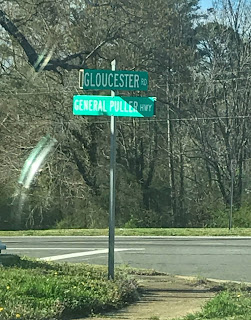Lt. Gen. Lewis Burwell Puller (1898-1971) had the unique nickname Chesty. Perhaps he earned it for the dozens of medals he wore on his chest during a military career matched by few in our nation’s history. (I know that's not the reason- but click here for more on the "Chesty" origins).
I became interested in Gen. Puller after recently watching on TV the fine Stephen Spielberg and Tom Hanks- produced dramatic HBO miniseries “The Pacific.” Released in 2010, the 10 episodes document the bloody battles fought by the U.S. Marine Corps against the Japanese in World War II’s Pacific theater.
Then a lieutenant colonel, Puller (played by William Sadler) appears in some episodes as a rugged commander who his Marines seemed to really like and respect.
Fast forward to the Northern Neck region of Virginia where my parents live and our Easter visit with them last week. Driving to their house over the years I had noticed the General Puller Highway signs as we drove through the Northern Neck area.
After watching and greatly enjoying the riveting “The Pacific” series, I did some research. I learned that puller was from this area where my folks live. He was born in West Point, Va. (not West Point, N.Y.), a lumber mill town that we go through after exiting Interstate 64 east of Richmond.
(As an aside West Point has a Chesty Puller 10K run. This year, the 13th annual, will be held on June 26. Here is the event's Facebook site.)
I also learned that puller was buried in the Northern Neck at this Episcopal Church graveyard near Saluda off, of course, General Puller Highway (aka Highway 33).
So, I made a plan to try to find his gravesite to photograph it and pay respects to the great leader who fought at famous battles such as Guadalcanal and Peleliu in World War II and Inchon and Chosin Reservoir in the Korean War.
Records related to Christ Church go as far back as 1666. In 1712, according to the church’s website, there were calls for a new brick structure to replace the wooden one. The parish was “disestablished” during the Revolutionary War and the church building fell into disrepair. It started to be repaired in 1840 and would become, basically, the small church we see today.
The walled churchyard, tidy and well maintained, wraps around the building.
Plenty of early Virginians are buried here. This plaque identifies a few dozen, including six “Patriots of the (American) Revolution.”
A helpful sign lists 132 burial sites. It also points out the oldest graves.
Nice! If only all old churchyards had signs like this!
Already on the road for more than eight hours we were eager to finally get to my parents’ house. So after a little effort to find the church and its graveyard I didn’t want to spend too much time searching for Gen. Puller’s grave.
It’s a lovely old graveyard that I hope to visit again with more time to give it. I didn’t spot the above directory until after finding the Puller grave.
Ok, do you think Puller’s might be this grave with the U.S. Marine Corps and U.S. flags around it? Of course it is!
This nearby marker was spotted afterward. It indicates that Puller’s grave is a big attraction here. In fact, while we were on the grounds a young couple drove up and looked at the Puller site.
The large flat ledger-style marker features the iconic U.S. Marine Corps eagle, globe and anchor emblem.
You see the rest of the inscription here. Pretty straightforward as I imagine the Marine commander was in life.
Lewis Sr. attended Virginia Military Institute but withdrew in 1918, joining the Marines because he wanted to see combat action in World War I. By the time he completed his Marine Corps training the war had ended.


















No comments:
Post a Comment